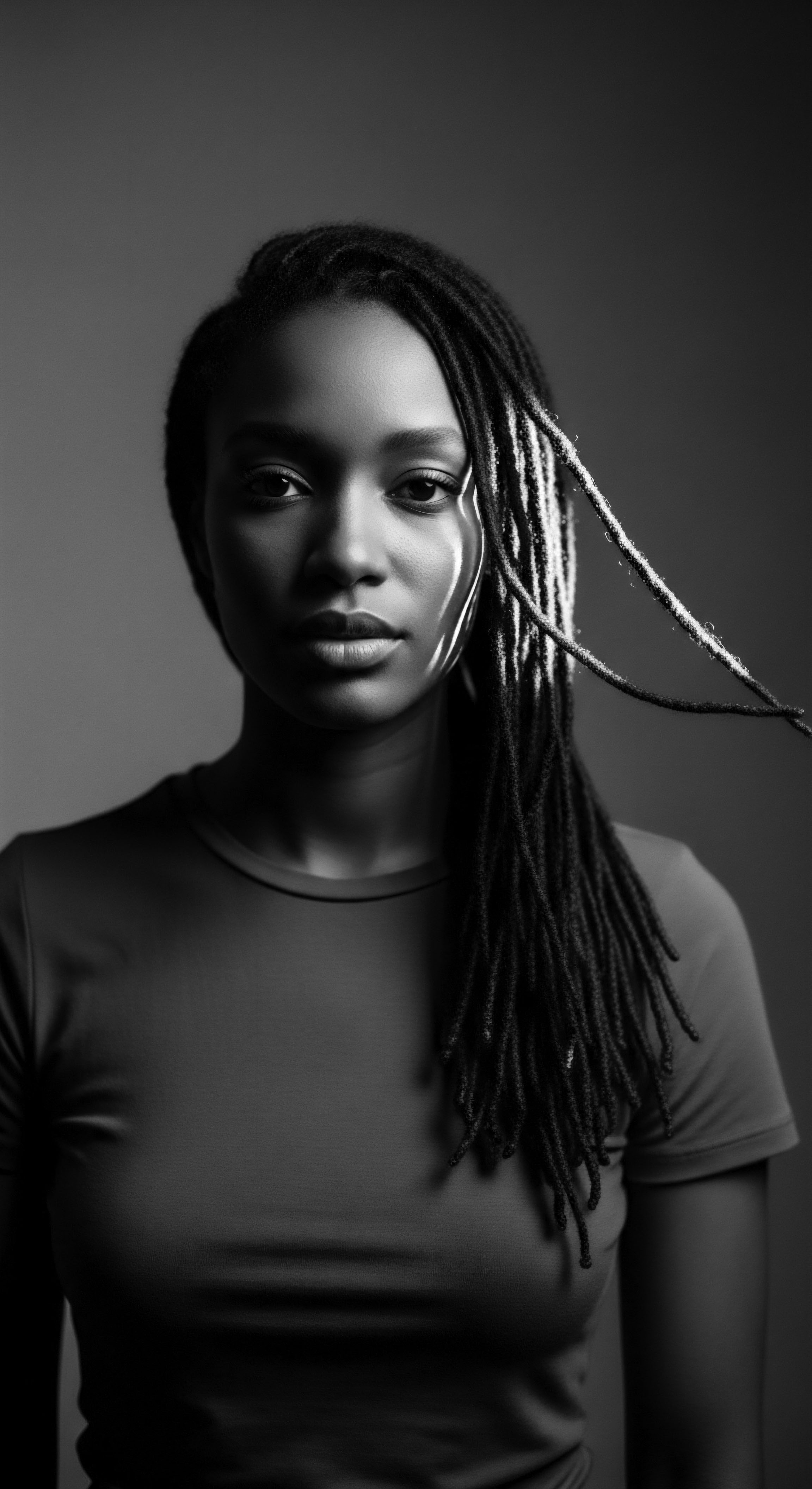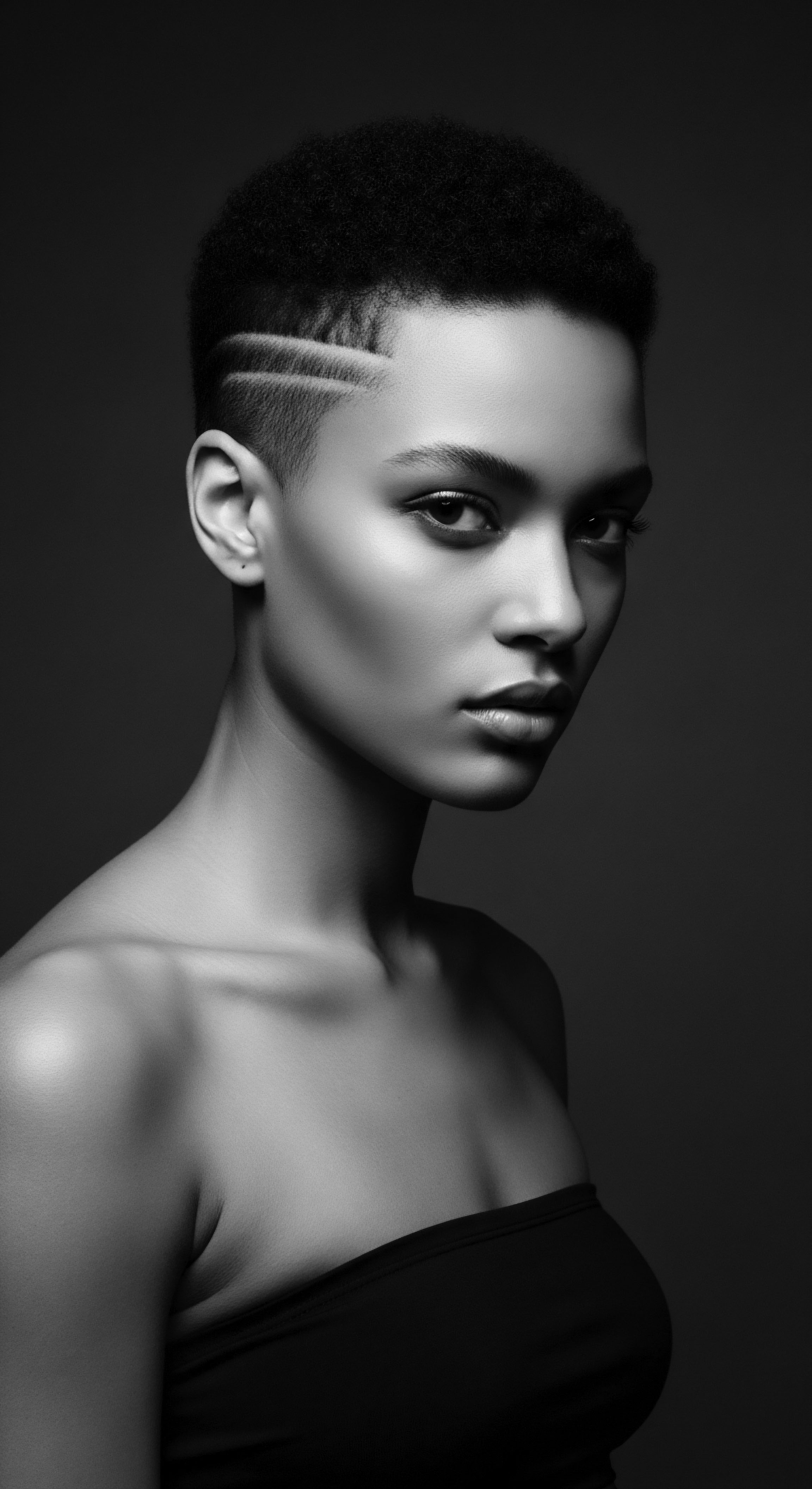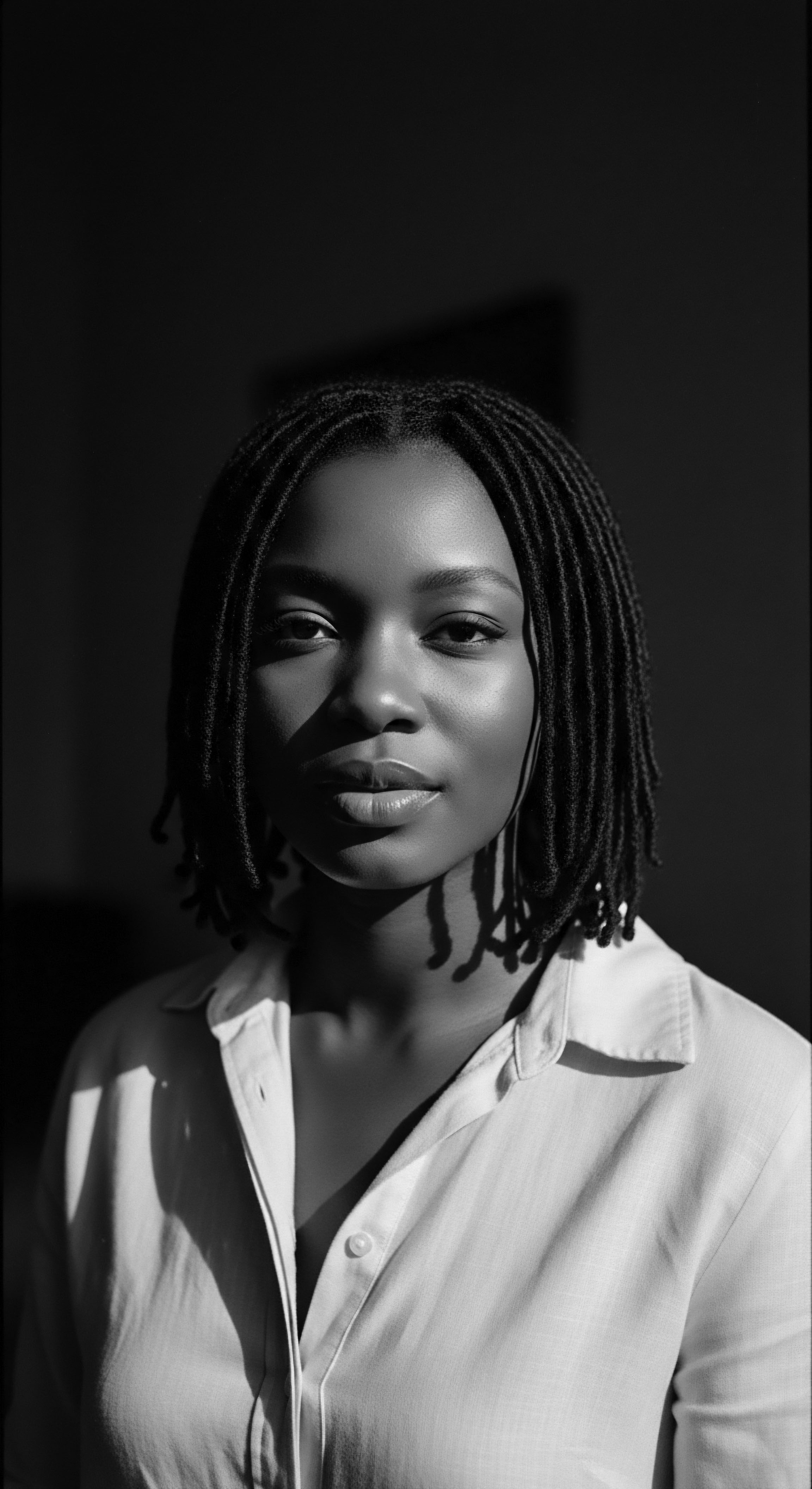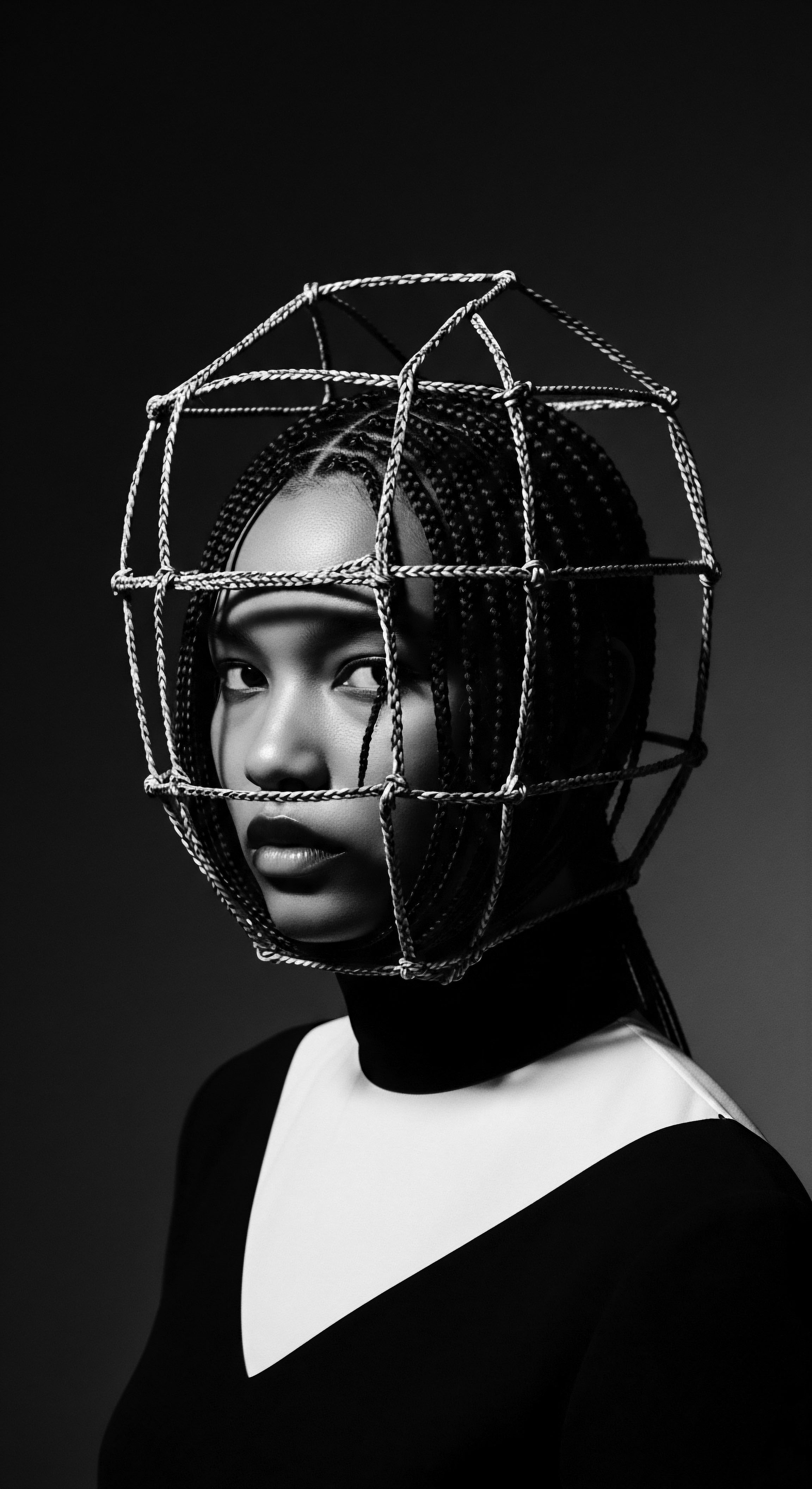
Roots
Consider for a moment the very strands that spring from your scalp. They are not simply fibers; they are living archives, each helix a repository of ancestral memory, whispered stories of sun-drenched savannas, bustling marketplaces, and intimate family circles. In the rich tapestry of textured hair’s long journey, oils have held a place not merely as emollients, but as sacred conduits, linking past generations to the present through ritual, science, and the profound wisdom of collective care.
The conversation surrounding textured hair’s unique biology often begins with its distinct curl pattern, its elasticity, and its inherent thirst. Yet, to truly grasp its nature, one must look beyond the immediate and towards the deep history that shaped both the hair itself and the practices surrounding its care. From the earliest human civilizations, where knowledge passed from elder to youth, the properties of botanicals were observed, tested, and reverently adopted. Oils, drawn from the earth’s bounty, became companions to these precious strands.

Hair’s Elemental Design and Early Protectors
Textured hair, with its elliptical follicle shape and varied curl patterns – from gentle waves to tightly coiled formations – possesses a unique architecture. This structure, while granting it incredible volume and sculptural capability, also means that the natural sebum produced by the scalp travels down the hair shaft with greater difficulty. This inherent characteristic, a biological design, underscored the early and continued need for external lubrication and protection.
Ancient communities, without the aid of microscopes, perceived this need through observation and generational experience. They noticed the hair’s tendency towards dryness, its susceptibility to breakage, and its vibrant response to specific plant exudates.
Early care was guided by an intuitive understanding of hair’s basic needs ❉ moisture, strength, and environmental defense. The oils they selected were not random. They were sourced from plants native to their immediate environments, reflecting a deep connection to the land and its offerings. These oils formed a vital shield against harsh sun, dry winds, and abrasive elements encountered in daily life.
Oils served as ancient guardians for textured hair, their historical use rooted in an intuitive understanding of its biological distinctiveness.

Ancestral Knowledge of Botanical Gifts
The wisdom of our forebears regarding hair care was encyclopedic, though unwritten in the formal sense. It lived in hands that braided, in songs that accompanied washing, and in the careful preparation of plant-derived remedies. This knowledge, passed through oral traditions, was a living science.
Among the earliest and most widespread botanical gifts utilized were those from the Shea tree, the Palm, and the Coconut. Each offered distinct properties, cherished for their ability to soften, protect, and revitalize the hair. These substances were not merely applied; they were often warmed, infused with herbs, or combined with other natural elements in elaborate processes that spoke to their deep regard for hair as a living entity.
Consider the reverence for the Shea tree (Vitellaria paradoxa) across West Africa. Its rich butter, extracted from the nuts, provided unparalleled emollition for skin and hair. Women, often organized into collectives, processed the shea nuts through painstaking traditional methods, a communal labor that underscored the value of the final product.
This butter, along with various oils, became a foundation for hair health and styling, preserving the hair’s integrity in often challenging climates. Its use wasn’t just about appearance; it was about protecting the very fiber that identified communities, marked status, and communicated stories.

How Did Ancient Societies Identify Hair Needs?
Without scientific instruments, how did ancient societies accurately assess the needs of textured hair and the efficacy of oils? The answer resides in centuries of lived experience and keen observation. They understood the hair’s reaction to different environments, the way certain substances made it feel, its resilience, or its breakage.
- Tactile Feedback ❉ The feeling of softness, elasticity, or brittleness guided their choice of emollient. Dry, brittle hair indicated a need for rich, protective oils.
- Visual Assessment ❉ Shine, vibrancy, and the absence of flakiness signaled healthy hair. Dull or ashen hair prompted the application of nourishing oils.
- Environmental Adaptation ❉ Hair exposed to intense sun, dust, or harsh winds required heavier, occlusive oils to create a barrier, a practice that mirrors modern understanding of environmental stressors.
- Trial and Error Over Generations ❉ Specific plant oils were used for particular hair conditions, not by random chance, but through collective wisdom accumulated and refined over countless generations.
These observations, refined over time, formed a lexicon of care that, while not framed in chemical terms, was profoundly effective. The practice of oiling became interwoven with daily life, a consistent act of preservation and honor for the hair, an act that maintained its integrity and reflected community values.
The historical role of oils in textured hair care is therefore not a mere footnote; it is a foundational chapter. It speaks to humanity’s early grasp of botanical properties, the ingenuity of ancestral communities, and a deep respect for the hair’s biological design. These roots continue to sustain and inform contemporary practices, forming a resilient legacy.

Ritual
Beyond the elemental understanding of hair’s design, the application of oils transformed into a profound ritual, a dance of hands and natural bounty that carried cultural weight far beyond simple aesthetics. This practice, a tender thread woven through the fabric of daily life, cemented the place of oils at the very heart of textured hair heritage. Hair care, particularly for textured strands, was seldom a solitary act; it was a communal affair, often taking place in gathering spaces, under the shade of trees, or within the comforting walls of family homes. Here, skills were transmitted, stories shared, and bonds deepened through the repetitive, nurturing motions of oiling, detangling, and styling.
The very act of oiling was imbued with meaning. It was an expression of care, a gesture of affection, and a means of preserving health and beauty across generations. Young girls watched their mothers and grandmothers, learning not just the technique, but the spirit of the ritual.
Boys, too, would often have their hair cared for by female relatives, experiencing the comforting touch and the aroma of natural oils. This intergenerational exchange ensured the continuity of these vital practices, safeguarding a body of knowledge that was both practical and deeply spiritual.

The Oiling Ceremony and Protective Styling
Oils played a critical part in the longevity and efficacy of traditional protective styles. Before braiding, twisting, or coiling, hair was often prepped with specific oils, chosen for their ability to lubricate the strands, minimize friction, and seal in moisture. This careful preparation was not just about making the styling easier; it was about ensuring the hair’s health while it was tucked away, safeguarded from environmental elements and manipulation.
Consider the ubiquitous cornrow or various forms of plaiting. These styles, deeply rooted in African civilizations, served not only as aesthetic expressions but also as practical solutions for hair management. Oils like palm oil or unrefined coconut oil were worked into the hair and scalp during the styling process.
This application provided a sustained protective coating, ensuring the hair remained supple and strong during the weeks or months these styles were worn. The meticulous sections, the tight yet gentle tension, and the consistent oiling were all elements of a masterful system of hair preservation.
Oiling textured hair was a shared practice, a communal ritual fostering connection and the transmission of ancestral wisdom through generations.

Which Oils Were Preferred in Early Hair Care?
The selection of oils was often dictated by regional availability and perceived efficacy. While specific botanical names might differ, the categories of beneficial lipids were remarkably consistent across various African and diasporic communities.
- Palm Oil ❉ Widely used in West and Central Africa, it was celebrated for its rich, reddish hue and its conditioning properties. It offered a significant source of vitamins, acting as a potent nourishing agent for both scalp and hair.
- Coconut Oil ❉ A staple in coastal West Africa, the Caribbean, and parts of Asia, its lighter consistency and deep penetrating ability made it ideal for moisture retention and adding luster. Its antimicrobial properties were also intuitively recognized for scalp health.
- Shea Butter ❉ From the Sahelian belt of West Africa, this dense, creamy butter was a powerhouse of moisture and a protective balm. Its presence in traditional hair preparations speaks to its high regard for extreme conditioning.
- Castor Oil ❉ Known in various forms across Africa and the Caribbean, particularly the dark, potent Jamaican Black Castor Oil, it was revered for its supposed ability to promote hair growth and thicken strands. Its thick viscosity made it perfect for sealing moisture into thirsty coils.
These oils were not simply mass-produced commodities; they were often harvested, processed, and prepared within the community, sometimes infused with local herbs or warmed over fires to enhance their properties, transforming them from raw materials into potent elixirs.

From Practicality to Identity
The role of oils in these styling rituals extended beyond mere practicality. Hair, in many African societies, was a symbol of identity, status, and spiritual connection. The careful application of oils before and during styling was an act of honoring these symbols. Elaborate hairstyles, made possible and preserved by the use of oils, often communicated age, marital status, tribal affiliation, or social standing.
During periods of great societal upheaval, such as enslavement and the diaspora, the continuity of these hair care rituals, including the use of traditional oils, became acts of profound cultural preservation and resistance. Stripped of so much, individuals held onto what they could ❉ the memory of ancestral hands in their hair, the familiar scent of palm or coconut oil, the rhythm of braiding. These practices became a quiet, yet powerful, assertion of self and connection to a lost homeland. The illicit cultivation of certain plants, or the clandestine trade of ingredients, speaks volumes to the deep-seated significance of these traditions.
| Oil Source Shea Butter |
| Traditional Uses in Textured Hair Care Intense conditioning, scalp protection, sealant for braids and twists. |
| Cultural/Historical Resonance Symbol of communal labor and women's economic agency in West Africa. |
| Oil Source Palm Oil |
| Traditional Uses in Textured Hair Care Nourishing scalp treatment, hair strengthening, vibrant color. |
| Cultural/Historical Resonance Integral to West African ceremonies, culinary practices, and ancestral remedies. |
| Oil Source Coconut Oil |
| Traditional Uses in Textured Hair Care Moisture retention, gloss enhancement, light sealing for curls. |
| Cultural/Historical Resonance Emblematic of island heritage and survival; often linked to spiritual purity. |
| Oil Source Castor Oil |
| Traditional Uses in Textured Hair Care Hair growth stimulation, thickening, intense sealing for coarse hair. |
| Cultural/Historical Resonance A legacy of Caribbean ingenuity, particularly Jamaican Black Castor Oil, used for medicinal and cosmetic purposes. |
| Oil Source These oils, more than mere ingredients, represent continuous links to ancestral lands and the resilience of textured hair traditions. |
The ritualistic application of oils, therefore, solidified its role as a fundamental aspect of textured hair care. It sustained healthy hair, yes, but it also sustained identity, community, and the memory of a heritage fiercely guarded. This deep-seated practice continues to influence modern routines, underscoring the enduring power of ancestral wisdom.

Relay
The journey of oils within textured hair heritage, from elemental understanding to cherished ritual, now culminates in its relay through generations, an ongoing dialogue between ancient wisdom and contemporary understanding. This relay is not a passive transfer; it is a dynamic process, a constant reinterpretation and reapplication of ancestral practices in the face of evolving social landscapes and scientific discoveries. Oils have become powerful symbols in this ongoing dialogue, embodying resilience, self-determination, and a reclamation of beauty narratives.
As textured hair moved through different historical eras, particularly the periods marked by the pervasive influence of Eurocentric beauty standards, the use of oils often became a silent act of defiance. Maintaining one’s natural hair, and the traditions associated with it, resisted pressures to conform. This quiet steadfastness in practicing traditional care, relying on the age-old benefits of oils, allowed for the continuity of a deeply personal and communal heritage, even when it was challenged or deemed undesirable by the dominant culture.

Reclaiming Identity Through Oiled Strands
The mid-20th century saw significant movements in Black identity, with hair becoming a prominent symbol of cultural pride and political assertion. The embrace of natural textures, often styled with the aid of traditional oils, was a powerful statement. This period witnessed a renewed interest in ancestral practices, not just as nostalgic pursuits, but as active tools of empowerment. Oils, once a quietly used ingredient, gained prominence as visible components of a self-care regimen that celebrated inherent beauty.
Scientific research, albeit often lagging behind traditional knowledge, has begun to validate the efficacy of many oils long used in textured hair care. For instance, studies on the molecular structure of coconut oil have shown its ability to penetrate the hair shaft, reducing protein loss during washing (Rele & Mohile, 2003). Similarly, the occlusive properties of heavier oils and butters like shea butter and castor oil effectively seal moisture into the hair, mitigating dryness, a common concern for textured hair due to its unique coil structure and cuticle layer. This modern validation provides a scientific echo to the centuries of experiential knowledge.
The historical use of oils in textured hair represents a powerful cultural relay, connecting ancestral practices with contemporary identity and scientific understanding.

How Do Oils Support Scalp Wellness in Heritage Practices?
The role of oils extends beyond the hair shaft to the scalp, which ancestral communities understood as the foundation of healthy hair. Traditional oiling practices often involved massaging oils directly onto the scalp. This was not simply a pleasant sensation; it was a therapeutic act aimed at maintaining a healthy microenvironment for hair growth.
Many traditional oils possess inherent antimicrobial or anti-inflammatory properties. For example, anecdotal and some preliminary research suggests certain components in castor oil may promote blood circulation when massaged into the scalp, potentially aiding nutrient delivery to hair follicles. In West African and Caribbean traditions, infused oils—where herbs like rosemary, peppermint, or neem leaves were steeped in carrier oils—were specifically prepared to address scalp conditions, such as flakiness or irritation. This targeted approach to scalp wellness, rooted in botanical understanding, predates modern dermatology by centuries.
The holistic approach to hair care meant viewing the scalp not in isolation but as an integrated part of overall health. Nutritional deficiencies, stress, and environmental factors were often considered alongside topical treatments. Oils were a part of this broader wellness philosophy, supporting a vibrant scalp as the source of flourishing hair.

The Socio-Economic Impact of Traditional Oils
The production and trade of traditional oils also carried significant socio-economic implications within communities, particularly for women. In many West African societies, the processing of shea butter or palm oil was, and remains, a vital source of income and female economic independence. The labor-intensive process, often performed communally, reinforced social bonds and provided economic sustenance. This economic dimension links the physical product—the oil—to larger questions of community autonomy and inherited livelihoods.
The value placed on these oils by ancestral communities stands in stark contrast to periods when textured hair itself was devalued. The continuity of their use, even in the face of adverse societal pressures, speaks to an unwavering belief in their inherent worth and the worth of the hair they nourished. This steadfast commitment to inherited care methods represents a profound act of cultural memory.
Indeed, studies exploring hair care practices within diasporic communities consistently highlight the enduring preference for natural oils. For instance, in an ethnographic study of Black women’s hair care in the United States, sociologist Alisha R. Jones (2016) observed that despite the proliferation of commercial products, traditional oils like coconut oil, olive oil, and castor oil remain mainstays in personal regimens, passed down from mothers to daughters. This sustained use, often accompanied by oral histories of their benefits, powerfully demonstrates the active relay of ancestral wisdom, adapting to new contexts yet retaining its foundational principles.
This is not simply a preference for natural ingredients; it is a reaffirmation of heritage, a tangible link to forebears who first understood and honored the capacities of these botanical gifts. The oils, therefore, continue to be central to a living, evolving heritage.

Reflection
As we trace the path of oils through the vibrant legacy of textured hair, a powerful truth emerges ❉ these seemingly simple botanical offerings are far more than conditioning agents. They are threads of memory, woven through generations, carrying the scent of homeland, the touch of ancestral hands, and the enduring wisdom of resilience. From the intuitive grasp of hair’s biological needs in ancient times to the communal rituals that shaped identity and the contemporary scientific validations echoing ancient truths, oils have been steadfast companions to textured strands.
The story of oils in textured hair is a living archive, breathing with the spirit of the ‘Soul of a Strand’—a recognition that each coil and wave holds a narrative of perseverance and beauty. This journey highlights not only the practical ingenuity of our forebears but also their profound respect for the gifts of the earth and the human body. The oils remind us that care, especially for textured hair, is often an act of honoring heritage, a continuous conversation with those who came before us. This legacy continues to write itself, strand by luminous strand.

References
- Rele, A. S. & Mohile, R. B. (2003). Effect of mineral oil, sunflower oil, and coconut oil on prevention of hair damage. Journal of Cosmetic Science, 54(2), 175-192.
- Jones, A. R. (2016). Black Hair in a White World ❉ The Social and Cultural Construction of Beauty. University of California Press.
- Oyelami, O. A. Oninla, A. O. Adeyemi, L. A. & Olagbende-Dada, A. O. (2003). The use of palm kernel oil in Nigerian traditional skin and hair care. International Journal of Dermatology, 42(5), 358-360.
- Kari, N. & Odum, C. O. (2019). The Role of Shea Butter in African Traditional Hair Practices. Journal of African Studies and Research, 6(1), 45-58.
- Hunter, L. (2011). Buying Black ❉ The American Way to Consume. University of North Carolina Press.
- Byrd, A. D. & Tharps, L. D. (2001). Hair Story ❉ Untangling the Roots of Black Hair in America. St. Martin’s Press.
- Nwankwo, C. (2005). Traditional African Medicine ❉ A Historical Perspective. Fountain Publishers.
